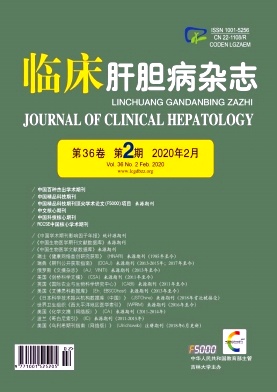|
[1] YANG LY. Attention to the surgical treatment of portal hypertension in China[J]. Chin J Dig Surg,2018,17(10):971-975.(in Chinese)杨连粤.重视我国门静脉高压症外科治疗的问题[J].中华消化外科杂志,2018,17(10):971-975.
|
|
[2] GARCIA-TSAO G,ABRALDES JG,BERZIGOTTI A,et al.Portal hypertensive bleeding in cirrhosis:Risk stratification,diagnosis,and management:2016 practice guidance by the American Association for the study of liver diseases[J]. Hepatology,2017,65(1):310-335.
|
|
[3] LV Y,QI X,HE C,et al. Covered TIPS versus endoscopic band ligation plus propranolol for the prevention of variceal rebleeding in cirrhotic patients with portal vein thrombosis:A randomised controlled trial[J]. Gut,2018,67(12):2156-2168.
|
|
[4] SANYAL AJ,FREEDMAN AM,LUKETIC VA,et al. The natural history of poral hypertension after transjugular intrahepatic portosystemic shunts[J]. Gastroenterology,1997,112(3):889-898.
|
|
[5] TAN HK,JAMES PD,SNIDERMAN KW,et al. Long-term clinical outcome of patients with cirrhosis and refractory ascites treated with transjugular intrahepatic portosystemic shunt insertion[J]. J Gastroenterol Hepatol,2015,30(2):389-395.
|
|
[6] RÖSSLE M. TIPS:25 years later[J]. J Hepatol,2013,59(5):1081-1093.
|
|
[7] PERARNAU JM,LE GOUGE A,NICOLAS C,et al. Covered vs. uncovered stents for transjugular intrahepatic portosystemic shunt:A randomized controlled trial[J]. J Hepatol,2014,60(5):962-968.
|
|
[8] DING ZF,YIN SW. Application of Viatorr covered stent in transjugular intrahepatic portosystemic shunt[J]. J Clin Hepatol,2018,34(5):1007-1110.(in Chinese)丁智锋,殷世武.Viatorr覆膜支架在经颈静脉肝内门体分流术中的应用现状[J].临床肝胆病杂志,2018,34(5):1107-1110.
|
|
[9] HAN G,QI X,HE C,et al. Transjugular intrahepatic portosystemic shunt for portal vein thrombosis with symptomatic portal hypertension in liver cirrhosis[J]. J Hepatol,2011,54(1):78-88.
|
|
[10] NICOLAS C,D’ALTEROCHE L,PERARNAU JM. Reply to:“Shunt dysfunction:Is it suitable as the primary end point in transjugular intrahepatic portosystemic shunt trials?”[J]. J Hepatol,2015,62(1):247-248.
|
|
[11] CHEN Q,ZHANG Y,YUE ZD,et al. Clinical efficacy of transjugular intrahepatic portosystemic shunting for recurrent portal hypertension after liver transplantation[J]. Chin J Dig Surg,2018,17(10):1013-1017.(in Chinese)陈权,张裕,岳振东,等.经颈静脉肝内门体分流术治疗肝移植术后再发门静脉高压症的临床疗效[J].中华消化外科杂志,2018,17(10):1013-1017.
|
|
[12] KHAN S,TUDUR SC,WILLIAMSON P,et al. Portosystemic shunts versus endoscopic therapy for variceal rebleeding in patients with cirrhosis[J]. Cochrane Database Syst Rev,2006(4):CD000553.
|
|
[13] SAXON RR,MENDEL-HARTVIG J,CORLESS CL,et al. Bile duct injury as a major cause of stenosis and occlusion in transjugular intrahepatic portosystemic shunts:Comparative histopathologic analysis in humans and swine[J]. J Vasc Interv Radiol,1996,7(4):487-497.
|
|
[14] SZE DY,VESTRING T,LIDDELL RP,et al. Recurrent TIPS failure associated with biliary fistulae:Treatment with PTFEcovered stents[J]. Cardiovasc Intervent Radiol,1999,22(4):298-304.
|
|
[15] DUCOIN H,EL-KHOURY J,ROUSSEAU H,et al. Histopathologic analysis of transjugular intrahepatic portosystemic shunts[J]. Hepatology,1997,25(5):1064-1069.
|
|
[16] TRIPATHI D,HELMY A,MACBETH K,et al. Ten years’follow-up of 472 patients following transjugular intrahepatic portosystemic stent-shunt insertion at a single centre[J]. Eur J Gastroenterol Hepatol,2004,16(1):9-18.
|
|
[17] JIRKOVSKY V,FEJFAR T,SAFKA V,et al. Influence of the secondary deployment of expanded polytetrafluoroethylene–covered stent grafts on maintenance of transjugular intrahepatic portosystemic shunt patency[J]. J Vasc Interv Radiol,2011,22(1):55-60.
|
|
[18] THEN EO,ARE VS,LOPEZ-LUCIANO M,et al. Elevated international normalized ratio:A risk factor for portal vein thrombosis in cirrhotic patients[J]. Gastroenterology Res,2019,12(3):135-140.
|
|
[19] GOU YY,HE S,WU KL,et al. Clinical features and treatment of 160 cases of liver cirrhosis with portal vein thrombosis[J].Chin J Dig,2018,38(7):455-460.(in Chinese)苟园园,何松,吴开玲,等.肝硬化门静脉血栓160例的临床特点和治疗分析[J].中华消化杂志,2018,38(7):455-460.
|
|
[20] HARDING DJ,PERERA MT,CHEN F,et al. Portal vein thrombosis in cirrhosis:Controversies and latest developments[J].World J Gastroenterol,2015,21(22):6769-6784.
|
|
[21] LV Y,HE C,WANG Z,et al. Association of nonmalignant portal vein thrombosis and outcomes after transjugular intrahepatic portosystemic shunt in patients with cirrhosis[J]. Radiology,2017,285(3):999-1010.
|
|
[22] WANG Q,LV Y,BAI M,et al. Eight millimetre covered TIPS does not compromise shunt function but reduces hepatic encephalopathy in preventing variceal rebleeding[J]. J Hepatol,2017,67(3):508-516.
|
|
[23] REVERTER E,TANDON P,AUGUSTIN S,et al. A MELDbased model to determine risk of mortality among patients with acute variceal bleeding[J]. Gastroenterology,2014,146(2):412-419.
|
|
[24] CASADABAN LC,PARVINIAN A,ZIVIN SP,et al. MELD score for prediction of survival after emergent TIPS for acute variceal hemorrhage:Derivation and validation in a 101-patient cohort[J].Ann Hepatol,2015,14(3):380-388.
|







 DownLoad:
DownLoad: